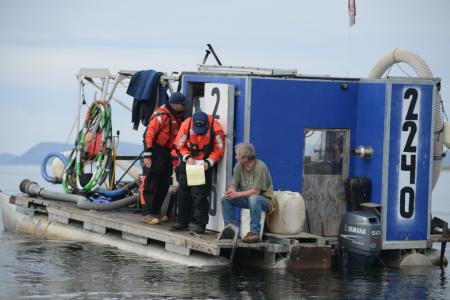Gold-dredging boats in Nome, Alaska get Coast Guard inspections

With another busy gold-dredging season underway in Nome, the U.S. Coast Guard just wound up an enforcement campaign to check gold seekers’ vessels for safety.
The 10-day operation resulted in onboard inspections of about 45 boats, about twice as many as boarded in a similar inspection operation last summer, said Cmdr. Shawn Decker, chief of response for the Coast Guard’s Anchorage sector. Inspected vessels included fishing boats and purely recreational watercraft but the vast majority of vessels undergoing safety checks in the Coast Guard’s Operation Gold Nugget were involved in the booming gold-dredging business, Decker said.
High commodities prices have inspired a modern-day gold rush in Nome, with most operations conducted offshore. That rush has been documented — and reinforced — by the Discovery Channel reality TV series “Bering Sea Gold,” scheduled to start a new season later this month.
Though they are used in a quest to strike gold riches, dredging boats are legally classified as recreational vessels, “which means that they need the same safety equipment as any recreational vessel of a similar size,” including life jackets, safety flares and fire extinguishers, Decker said.
Dredgers work up to about a mile offshore in cold waters that can be as deep as 100 feet, he said.
“Obviously, the gold dredging business is extremely dangerous,” he said. “Conducting it in Alaska makes it even more dangerous, and then you add the remoteness of Nome and it’s even more dangerous.” One miner drowned in 2011.
Gold-dredge operators appear to be taking the dangers seriously, and they are abiding by safety rules, Decker said. That may be thanks to educational outreach conducted by the Coast Guard this year and in previous years, he added.
The onboard inspections followed safety educational programs conducted this summer and in previous summers. All the Nome operations are part of the Coast Guard’s Arctic Shield program.
Contact Yereth Rosen at yereth@alaskadispatch.com
Related stories from around the North:
Canada: Drones help Yukon prospectors find gold deposits, CBC News
Finland: Gold mine for sale in northwest Finland, Yle News
Sweden: Mine applications hit new low in 2013, Radio Sweden
United States: Restoring the Tagish role in the Klondike gold rush, CBC News



